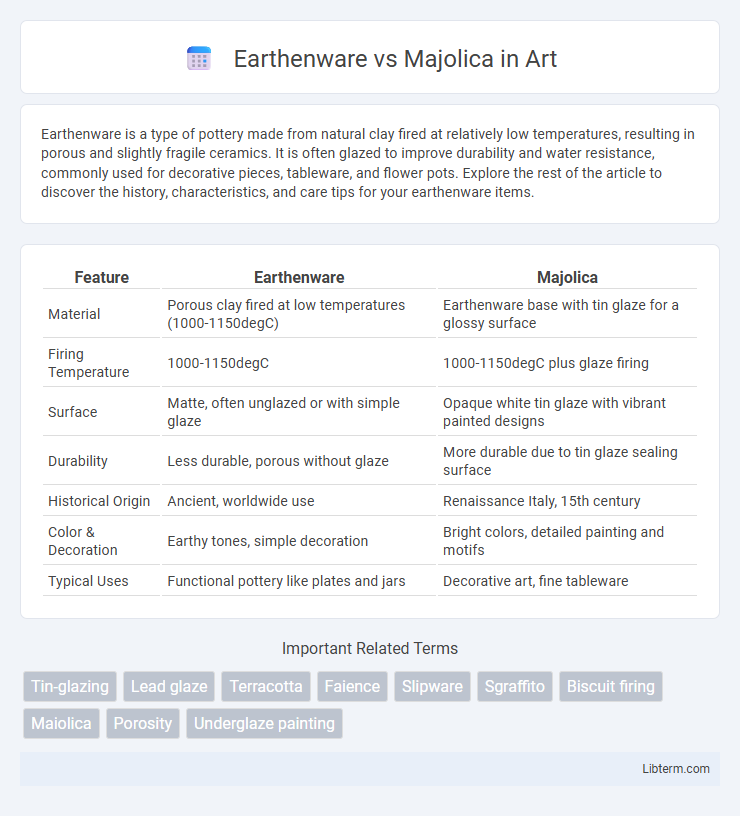Earthenware is a type of pottery made from natural clay fired at relatively low temperatures, resulting in porous and slightly fragile ceramics. It is often glazed to improve durability and water resistance, commonly used for decorative pieces, tableware, and flower pots. Explore the rest of the article to discover the history, characteristics, and care tips for your earthenware items.
Table of Comparison
| Feature | Earthenware | Majolica |
|---|---|---|
| Material | Porous clay fired at low temperatures (1000-1150degC) | Earthenware base with tin glaze for a glossy surface |
| Firing Temperature | 1000-1150degC | 1000-1150degC plus glaze firing |
| Surface | Matte, often unglazed or with simple glaze | Opaque white tin glaze with vibrant painted designs |
| Durability | Less durable, porous without glaze | More durable due to tin glaze sealing surface |
| Historical Origin | Ancient, worldwide use | Renaissance Italy, 15th century |
| Color & Decoration | Earthy tones, simple decoration | Bright colors, detailed painting and motifs |
| Typical Uses | Functional pottery like plates and jars | Decorative art, fine tableware |
Introduction to Earthenware and Majolica
Earthenware and Majolica are both types of ceramic pottery distinguished by their composition and glazing techniques. Earthenware is a porous, low-fired clay pottery usually glazed to make it watertight, commonly used for everyday functional items. Majolica refers specifically to tin-glazed earthenware featuring vibrant, opaque white surfaces decorated with colorful motifs, traditionally originating from the Italian Renaissance period.
Historical Origins and Development
Earthenware originated in ancient civilizations such as Mesopotamia and Egypt, characterized by its porous, low-fired clay composition, which has been used for utilitarian and decorative pottery for millennia. Majolica evolved during the Italian Renaissance as a refined type of earthenware, distinguished by its tin-glazed surface that allowed vivid polychrome decorations, reflecting advancements in ceramic glazing techniques and artistic expression. The historical development of majolica showcases a significant transformation from functional pottery to highly artistic ceramics, influenced by cultural exchanges and technological innovations in 15th-century Europe.
Defining Characteristics of Earthenware
Earthenware is a porous, low-fired ceramic material typically fired at temperatures between 1,000degC and 1,150degC, characterized by its opaque, coarse texture and soft, absorbent body. Unlike the tin-glazed majolica, earthenware's natural reddish or buff color results from iron-rich clays, and it often requires a clear or colored glaze to become water-tight. Its durability is less than stoneware or porcelain, making it ideal for decorative pottery and functional ware that does not require high thermal shock resistance.
Unique Features of Majolica
Majolica is distinguished by its vibrant tin-glazed surface that creates a glossy, opaque white background, allowing for intricate, colorful hand-painted designs. Unlike standard earthenware, which is porous and typically unglazed or simply glazed, majolica's glaze not only enhances aesthetic appeal but also provides a protective, non-porous finish. This unique combination of a white, reflective glaze and vivid pigments makes majolica a prized decorative ceramic technique, especially prominent in Renaissance Italy.
Materials and Production Techniques
Earthenware is made from a porous clay fired at lower temperatures around 1,000-1,150degC, resulting in a more porous and less durable ceramic body compared to stoneware or porcelain. Majolica, a type of earthenware, features a tin glaze applied before firing, creating an opaque white surface that is decorated with vibrant metallic oxide pigments and then refired at similar temperatures. The production technique of majolica involves a two-step firing process--first the bisque firing of the shaped clay, followed by glazing and a second firing--which enhances its decorative appeal and moisture resistance compared to plain earthenware.
Artistic Styles and Decorative Motifs
Earthenware typically features rustic, organic artistic styles with earthy tones and simple, hand-painted floral or geometric motifs reflecting traditional folk art. Majolica is renowned for its vibrant, glossy glazes and intricate, brightly colored designs often depicting mythological scenes, animals, and lush floral patterns inspired by Renaissance and Mediterranean aesthetics. Both styles exhibit unique cultural influences but differ in glazing techniques and level of ornamental detail, with Majolica emphasizing elaborate decoration and vivid coloration.
Durability and Everyday Use
Earthenware is a porous, less durable ceramic that requires glazing to be water-resistant, making it more prone to chipping and cracking with frequent use. Majolica, a type of tin-glazed earthenware, features a dense, glossy surface that enhances its durability and makes it suitable for everyday use while maintaining vibrant decoration. Both materials are suitable for tableware, but majolica offers better resistance to wear and staining in daily applications.
Cultural Significance and Influence
Earthenware and Majolica each hold distinct cultural significance rooted in their historical and regional origins, with Earthenware embodying ancient pottery traditions commonly found in everyday utilitarian objects across various civilizations. Majolica, originating from the Italian Renaissance, represents a refined ceramic art form characterized by brightly colored tin-glazed surfaces that symbolize artistic innovation and cultural luxury in European decorative arts. Both materials have influenced global ceramic trends, with Earthenware's versatile, earthy aesthetics contrasted by Majolica's vibrant, ornate designs serving as cultural markers in archaeological and art historical contexts.
Collecting and Valuing Earthenware vs Majolica
Collecting Earthenware involves seeking pieces characterized by their porous clay body and often rustic, utilitarian appearance, with value largely determined by age, provenance, and condition. Majolica, a type of tin-glazed Earthenware, commands higher collecting interest due to its vibrant, colorful glazes and intricate designs, with rarity and artisan origin significantly impacting market value. Both types require careful appraisal for authenticity and historical significance, but Majolica's decorative appeal often results in greater demand among collectors.
Choosing Between Earthenware and Majolica
Choosing between earthenware and majolica depends on the desired finish and durability; earthenware offers a porous, rustic texture ideal for decorative use, while majolica is glazed with vibrant, colorful designs that provide a waterproof and food-safe surface. Earthenware suits artisanal, handmade aesthetics but requires careful handling due to its fragility and porosity. Majolica's tin-glazed coating enhances strength and stain resistance, making it preferable for functional tableware and durable decorative pieces.
Earthenware Infographic

 libterm.com
libterm.com